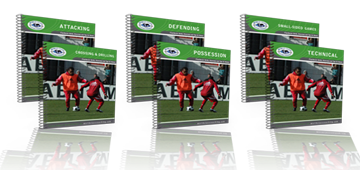By Lawrence Fine, Author of the FineSoccer Coaching Bible.
Safety is such an important part of youth soccer but it gets a lot more lip service than actual service.
The one topic that is mentioned most often is goal safety. We all know how important it is to make sure goals are secured but how many are actually doing it? Sadly a recent event is a good reminder of how important this is. A 9 year old child was killed in Arkansas recently due to a soccer goal falling. To see more, please go to http://www.4029tv.com/r-video/26631921/detail.html
As a coach, when you first get to the field, if there are goals there, make sure the goals are secure. It doesn't matter if the weather seems fine and there isn’t any wind in the area, this is something that has to happen EVERY TIME I was running a college training session a number of years ago and all of a sudden heavy winds started up and while the team was scrimmaging, BOTH GOALS blew over in opposite directions. We were very fortunate that both keepers were far enough off their lines that they weren't hit but it was a risk that wasn't worth taking (and we didn't take ever again).
Once you know the goals are secure, walk the are your team will be using for training. Even if it’s a field you use daily, you don’t know what might be there today. Broken glass, stray barbed wire etc can all do serious damage. Encourage your team to do the same. Taking a few minutes to walk the field can avoid unnecessary problems later.
Even before getting to the field, check the weather report. If there a storm coming through your area? Possible flooding? Lightning? At the very least this will give you an idea of what to be prepared for. If there is potential bad weather coming, is there shelter for your team to go to for safety? When the bad weather hits is NOT the time to start looking around, this is something you should do beforehand.
When dealing with lightning, if it weren't so sad, it would be funny watching the people count the seconds between the time they hear the thunder and see the lightning. This might tell you how far the last lightning was but it doesn't tell you where the next lightning is going to strike. Unfortunately, lightning doesn't always move in an orderly fashion so for us to act as if it does is quite naive. If there is lightning in the general area GET OFF THE FIELD AND INTO A SAFE LOCATION. I can assure you the time lost on the field is not worth the possible loss of a life. Also, you can purchase a small lightning detector for under $100 to be better prepared (see http://www.amazon.com/Strike-Alert-Personal-Lightning-Detector/dp/B0007SXJYE)
If at all possible, make sure you have a phone accessible. Unfortunately this is not always easy because some fields are in somewhat remote areas where cell service is not available but whenever possible, have a cell phone or landline available to call for help.
Make sure you have a first aid kit available. You can get a simple one from Kwik Goal at http://www.kwikgoal.com/product/12A3/player_first_aid_kit.html This will just cover the basic bandages, pads, creams etc but it’s certainly better than nothing.
There are many other things you can do to help ensure there are no unnecessary injuries. Inevitably, injuries do happen but if we can help prevent just one, it’s well worth it.
If you would like to share what you do to help keep your players safe, please do so in the comments below.
By Lawrence Fine, Author of the FineSoccer Coaching Bible.



